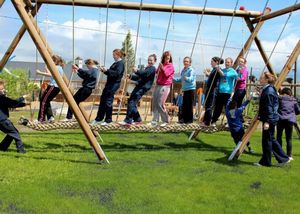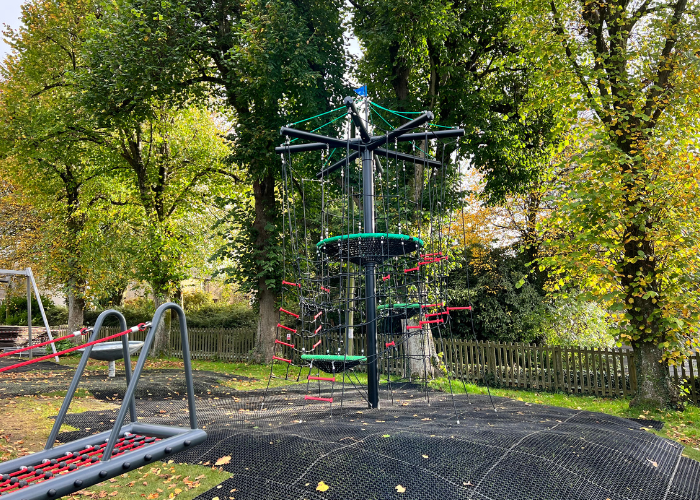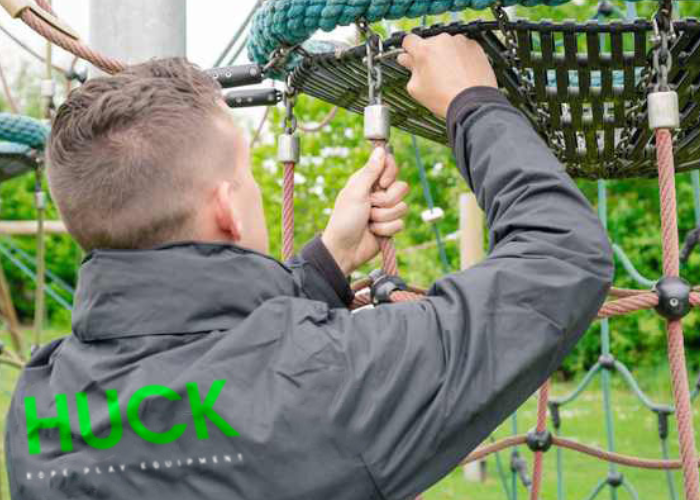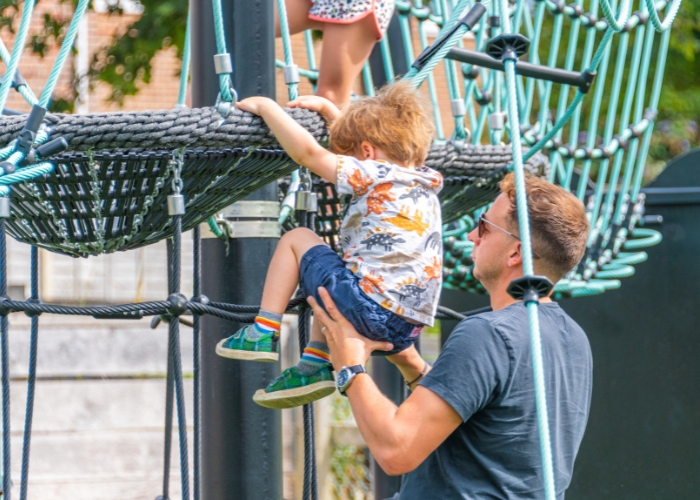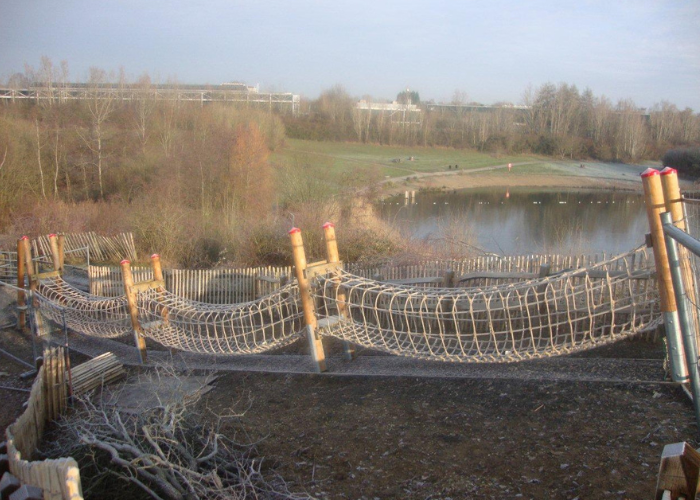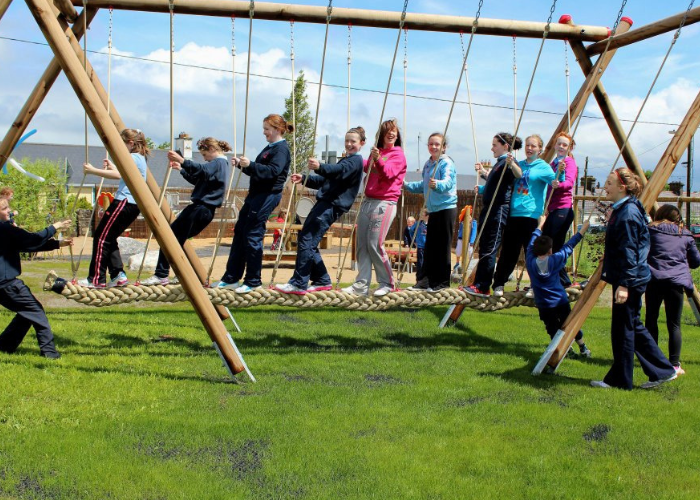7 Most Common Playground Hazards & How to Mitigate the Risks
Playgrounds are spaces that should be filled with fun, but they also naturally pose some risks. Being aware of the most common playground hazards is one step towards improving the safety of your park, but knowing how to mitigate them is even more important.
It’s your role as the responsible personnel to ensure safety in your space, and you likely would have already carried out a playground risk assessment as part of your planning (or you should be about to if you’re in the early stages).
Thankfully, there are some simple things that can help you reduce the likelihood of injury and increase play safety on your equipment.
From carrying out regular inspections to keeping the area clean and well-maintained, these small yet important tasks can make a big difference in ensuring a fun and safe play environment for children.
Most Common Hazards in a Playground
As with any kind of equipment that involves climbing, running, sliding, or swinging, playgrounds have some inherent risks and hazards that need to be minimised to keep the area safe and fun for all users.
We've picked out the top 7 most common playground hazards that should be considered when designing your play area.
1. Unsafe or Inadequate Playground Surfacing
Playground surfacing plays a crucial role in ensuring safety for both children and caregivers. Using unsafe, broken, or inadequate ground cover increases the risk of injuries from falls, trips, or slips.
Hard surfaces, such as concrete or asphalt, can lead to severe injuries if a child falls, while broken or worn-out surfaces may create uneven areas, posing a tripping hazard.
In addition, unsuitable materials can become slippery when wet, further endangering children and making it harder for caregivers to supervise effectively.
How to Reduce This Risk
To create a safer play environment, consider using appropriate ground cover options such as:
- Engineered wood fibre (EWF)
- Rubber mulch
- Impact-absorbing rubber mats or tiles
- Sand or pea gravel (as per safety standards)
- Poured-in-place rubber surfacing
Each of these options provides cushioning against falls and helps minimise risks, enhancing safety for all playground users.
2. Poorly Maintained Playground Equipment
Poorly maintained playground equipment can significantly increase the risk of accidents and injuries. Over time, equipment may suffer from wear and tear, leading to rusted metal parts, splintering wood, or frayed ropes, which can cause cuts, scrapes, or even more severe injuries.
Loose bolts or unstable structures can result in equipment collapsing or becoming unsafe to use. Broken or missing components, such as handrails or barriers, may also lead to falls or entrapments.
How to Reduce These Risks
Regular inspections, repairs, and maintenance are crucial to ensure that all equipment remains in good condition and safe for use.
By routinely checking for wear and tear, addressing potential issues early, and keeping everything well-maintained, you can extend the lifespan of the equipment and provide a safe, enjoyable experience for all users.
At Huck Play, we prioritise safety and quality, which is why we have a dedicated team of experts who conduct annual inspections on all our playgrounds. These thorough evaluations are designed to identify any potential issues, ensuring that the equipment remains safe, durable, and fully functional for users of all ages.
3. Falls From Climbing Equipment
Falls are an inherent risk with climbing play equipment, as children often test their limits, push boundaries, and explore new challenges.
While these experiences are essential for their physical and cognitive development, they can sometimes result in slips or missteps, especially as kids build their confidence and coordination.
How to Reduce This Risk
Despite how common playground falls are, you still want to minimise the risk. Here’s how you can do so…
- Adequate supervision is essential, ensuring that children are guided and supported during play.
- Installing safe ground coverings, such as rubber mats, wood chips, or sand, can help cushion falls and minimise the impact.
- Incorporating safety nets or guardrails around climbing structures can provide extra protection and prevent serious accidents.
By combining these precautions, playgrounds can remain a safe and enjoyable environment for all.
4. Lack of Adequate Shade & Shelter
Spending too much time in direct sunlight without shade can pose serious risks, especially for children.
Prolonged sun exposure can lead to heat-related illnesses, like heat exhaustion or heat stroke, which can be dangerous if not treated quickly.
How to Reduce This Risk
Adding shaded areas, such as pergolas, awnings, or benches, can provide relief from the sun and help keep playground users safe and comfortable.
If shade is difficult to provide in your park, putting up signs warning of the dangers of prolonged sun exposure or limiting usage in more supervised settings may be appropriate.
5. Injuries From Manually Propelled Play Equipment
Play equipment that requires children to move it with their own force — like swings, roundabouts, and see-saws — can be risky if they’re not properly maintained. Their fast or unpredictable movements can cause falls, loss of balance, or collisions.
How to Reduce These Risks
To make manually propelled equipment safer, they should be installed on soft, impact-absorbing surfaces, such as rubber mats or wood chips, to help cushion falls. Regular maintenance is also key to ensuring that moving parts are secure, working properly, and free of sharp edges or loose pieces.
Teaching children how to use the equipment safely — like sitting correctly and holding on — and providing adult supervision can greatly reduce the chance of accidents while still letting kids have fun.
6. A Lack of Adequate Supervision
Speaking of how playtime supervision can help minimise injuries, having a lack of adequate adult supervision, especially in a school playground, can pose a risk in and of itself. Without proper supervision, children may engage in risky behaviour or use equipment improperly, increasing their chances of getting hurt.
Additionally, supervision can also help identify and address potential hazards or maintenance issues before accidents occur.
How to Reduce This Risk
It's important for designated supervisors to be present and actively monitor the playground when children are playing. Proper ratios of caregivers and children should be maintained at all times when the play equipment is in use.
It's also important to make learning how to safely use the equipment part of your curriculum, especially for younger children who are more likely to hurt themselves.
Read more on this topic below…
School Playground Rules & Regulations You Need to Know
7. Hazards Caused By Cold Weather
Cold weather can make outdoor play equipment more dangerous. Low temperatures, snow, and ice create unsafe conditions, so regular maintenance and inspections are essential during the winter months. Here’s how cold weather can affect play equipment:
- Slippery Surfaces — Ice and frost can form on slides, swings, and climbing frames, making them slippery and increasing the risk of falls.
- Brittle Materials — Cold temperatures can make plastic and rubber parts brittle, which might cause them to crack or break during use.
- Freezing Metal — Metal equipment can get extremely cold, which could lead to frostbite or skin injuries if touched.
- Snow Cover — Snow can hide hazards like broken parts or uneven ground, making them harder to spot until an accident happens.
- Loose Fastenings — Changing temperatures can make screws and bolts expand and contract, loosening joints and weakening equipment.
How to Reduce These Risks
To keep play areas safe in cold weather, make sure to inspect equipment regularly, perform maintenance, and clear away snow and ice as needed.
You should also post prominent signs at entrances and around the playground to inform parents and caregivers of the risks posed by our more extreme weather conditions in the UK.
What are the Most Common Playground Injuries?
Some of the most common playground injuries include falls, cuts and bruises, fractures, dislocations, and concussions.
Falls are the leading cause of injuries, often happening when children lose their balance on climbing structures, monkey bars, or slides. Depending on the height and the type of surface below, these falls can result in anything from minor scrapes to serious fractures, dislocations, or head injuries.
Cuts and bruises usually occur when kids come into contact with sharp edges, loose bolts, or rough surfaces on poorly maintained equipment.
Concussions — which are more serious — often result from head impacts caused by falls or accidental hits from swings or other playground equipment.
How Can Playground Injuries Be Prevented?
To prevent playground injuries, having a comprehensive risk management plan in place is key to ensuring a safe environment for children. A well-rounded approach includes the following measures:
| Regular Inspections & Maintenance | Conduct routine checks of all play equipment and surfaces.
Identify and repair hazards like broken parts, rust, loose bolts, or sharp edges. Ensure adequate shock absorption with surfaces like rubber mats, wood chips, or sand. |
| Proper Layout Design | Design playgrounds with adequate spacing between equipment to avoid collisions and overcrowding.
Separate play areas by age groups to provide age-appropriate challenges and reduce injury risk. |
| Supervision | Provide adult supervision to prevent injuries by stopping unsafe behaviour, like pushing, overcrowding, or improper equipment use.
Ensure sufficient staff or guardians for multiple children. |
| Enforcing Age-Appropriate Use | Clearly label equipment with age guidelines and ensure children use equipment suited for their developmental stage.
Prevent younger children from using equipment designed for older children. |
| Educational Signage | Place visible signs with safety rules and instructions to encourage safe practices. Include reminders like "wait your turn" and warnings against climbing on non-climbing structures. |
If your park is free to access at any time by the public, it's important to engage the local community in maintaining the playground. Regular feedback from parents and caregivers can help identify potential hazards or areas for improvement.
You should also try to ensure your playground is designed to be inclusive of children of all abilities. Accessible features like ramps, tactile pathways, and inclusive swings promote safe play for everyone.
Obviously, you can't control the weather, but posting weather-related warnings, like those in housing estates, at entrances can help visitors stay informed of the risks that may be present during wet, cold, or hot weather conditions.
If your playground is part of school or preschool grounds, thanks to on-site staff, injury prevention is more effective. Other than providing adequate supervision during playtime, there are two main ways you can help prevent injuries in your park:
- Staff Training — Train teachers, caregivers, and supervisors in playground safety protocols, including how to identify risky behaviours, respond to emergencies, and administer basic first aid. Having trained personnel on hand can significantly reduce the severity of injuries.
- Emergency Preparedness — Ensure that emergency procedures are well-documented and easily accessible. Have a stocked first aid kit nearby and a clear plan for contacting emergency services.
Children also play a vital role in ensuring their own safety. Educate them on how to use the equipment correctly and explain why certain behaviours, such as jumping off swings or climbing outside designated areas, are risky.
What Goes Into a Playground Risk Assessment?
A thorough playground risk assessment should include several key elements to ensure the space is safe for all users:
- Inspection of Equipment: Check for any signs of damage, wear, or malfunction in playground structures, ensuring all equipment is safe and secure.
- Surface Safety: Evaluate the ground surfaces for appropriate cushioning materials like rubber or sand to minimise injury risks from falls.
- Age-Appropriate Design: Ensure that equipment is suitable for the intended age groups and check for potential hazards such as small parts or unsafe heights.
- Environmental Factors: Assess the surroundings for risks such as sharp objects, harmful plants, or proximity to traffic.
- Accessibility: Verify that the playground is inclusive, providing safe access for children of all abilities.
- Regular Maintenance Plan: Establish a schedule for routine inspections and maintenance to promptly address any issues.
Key Takeaways: Reducing the Risk of Playground Hazards
Every play area will throw up its own hazards and risks depending on the equipment, location and user group. However, by following the guidelines outlined above, you can minimise potential dangers and create a safe environment for children to play.
It cannot be overstated that proper maintenance and regular inspections are crucial in ensuring the safety of a playground. Conduct a thorough risk assessment, and always seek the advice of professionals if you’re unsure in how to proceed.
For more advice, guides, and tips on all things playgrounds, head to the Huck Play blog!
FAQs
What is a Safety Playground Checklist?
A safety playground checklist outlines steps to ensure a secure play area, including inspecting equipment for damage, maintaining soft surfacing, confirming age-appropriate designs, removing hazards, and scheduling routine maintenance to keep the playground safe for all children.
Who is Responsible for Playground Risk Management?
Playground risk management is typically the responsibility of the owner or operator, who ensures regular inspections, maintenance, and adherence to safety standards to create a secure environment for children and other users.
What Causes Trip Hazards on a Playground?
Trip hazards on a playground are caused by uneven surfaces, exposed tree roots, protruding bolts, misplaced play equipment, or wear and tear in surfacing materials, all of which can increase the risk of injuries if not addressed promptly.

